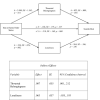Thwarted belongingness and perceived burdensomeness explain the associations of COVID-19 social and economic consequences to suicide risk
- PMID: 32589811
- PMCID: PMC7361587
- DOI: 10.1111/sltb.12654
Thwarted belongingness and perceived burdensomeness explain the associations of COVID-19 social and economic consequences to suicide risk
Abstract
Objective: The social and economic consequences of COVID-19 and related public health interventions aimed at slowing the spread of the virus have been proposed to increase suicide risk. However, no research has examined these relations. This study examined the relations of two COVID-19 consequences (i.e., stay-at-home orders and job loss) to suicide risk through thwarted belongingness, perceived burdensomeness, and loneliness.
Method: Online data from a nationwide community sample of 500 adults (mean age = 40) from 45 states were collected between March 27 and April 5, 2020. Participants completed measures assessing thwarted belongingness, perceived burdensomeness, loneliness, and suicide risk, as well as whether they (a) were currently under a stay-at-home order and (b) had experienced a recent job loss due to the pandemic.
Results: Results revealed a significant indirect relation of stay-at-home order status to suicide risk through thwarted belongingness. Further, whereas recent job loss was significantly correlated with suicide risk, neither the direct relation of job loss to suicide risk (when accounting for their shared relations to perceived burdensomeness) nor the indirect relation through perceived burdensomeness was significant.
Conclusions: Results highlight the potential benefits of interventions targeting thwarted belongingness and perceived burdensomeness to offset suicide risk during this pandemic.
© 2020 The American Association of Suicidology.
Figures


References
-
- Casler, K. , Bickel, L. , & Hackett, E. (2013). Separate but equal? A comparison of participants and data gathered via Amazon’s MTurk, social media, and face‐to‐face behavioral testing. Computers in Human Behavior, 29, 2156–2160. 10.1016/j.chb.2013.05.009 - DOI
MeSH terms
LinkOut - more resources
Full Text Sources
Medical
Miscellaneous

